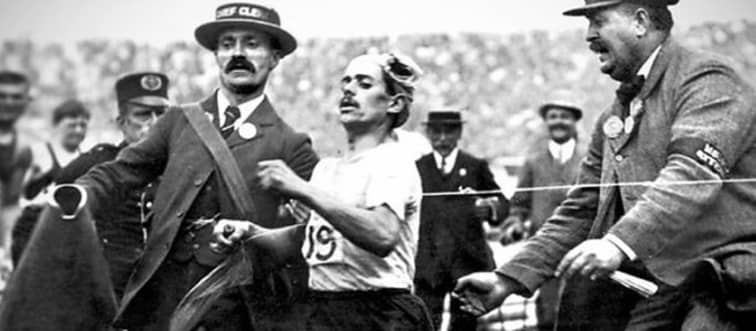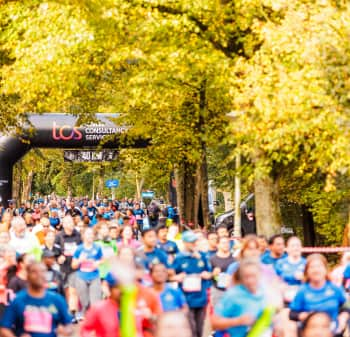
The marathon distance
Pietri Dorando, London Marathon 1908
Why is the marathon distance 42.195 km?
Today, all marathons around the world begin at the same precisely defined distance: 42.195 km. But behind this precise figure lies an astonishing story 📖. Between legend of ancient Greece 🏺, royal whim and historical happenstances, this mythical race has gained popularity over the centuries to become the queen distance of athletics 👑.
The Legend of Philippides: The Origins of the Marathon
Before becoming a legendary event, the marathon is first and foremost a story. An old tale that smells of battlefield dust and the sweat of a man running to save his people.
In 490 BC, the Greeks faced the Persians in a decisive battle at Marathon, a small village about forty kilometers from Athens. Although vastly outnumbered, the Athenians win the victory. Then, according to the most well-known legend, the military leaders send a soldier-messenger to run to Athens to announce the news. His name would be Philippides (or perhaps Thersippus or Eucle, depending on the version). But no matter his name: what is remembered is his feat.
This long-distance runner is one of the hemerodromes, messengers of ancient Greece capable of covering very long distances thanks to their physical condition and endurance. According to popular accounts, he ran nonstop the 35 to 40 kilometers between Marathon and Athens. Out of breath, he reached the Agora, shouted “Nikomen!” (“We have won!”), and then collapsed, overcome by the effort. A scenario worthy of the greatest films 🎞️, spanning centuries, blending patriotism, ultimate effort, and sacrifice.
But here’s the thing: this beautiful story, romantic as it may be, doesn’t quite fit historical sources. Herodotus, one of the few Greek historians 🇬🇷 and indirect witnesses of that time, never mentions a Marathon-Athens run in his manuscripts. In his writings, he mentions another feat—even more impressive: Philippides was sent from Athens to Sparta, a distance of 246 kilometers, to ask for help against the Persians. He ran that distance in just 36 hours. The Spartans, delayed by religious rites and a non-favorable lunar calendar, promised their support... but not for six days. The messenger immediately returned to warn Athens 📨.
Thanks to him, Athenian military leaders knew they couldn't count on Sparta in time. Miltiades, the Greek general, changed strategy 🎯. He decided to strike quickly, surprising the enemy troops. And it worked: despite being outnumbered, the Athenians crushed the Persians by attacking them by surprise ⚡.
Without Philippides, this victory might not have been possible. He may not have announced the victory; but he made it possible. And that's what makes his feat even more admirable. For many, historical accuracy is not the most important: a symbol was born. The symbol of the superhuman feat. By delivering his message at the cost of his life, this Greek messenger embodies extraordinary resilience. Unknowingly, he would inspire millions of runners, two millennia later.
The 1896 Athens Olympics: The Birth of the Marathon
It wasn't until the end of the 19th century that this legend took tangible form in modern sport. Greece 🇬🇷 had been organizing its own Olympic Games for years, but Pierre de Coubertin wanted to officialize them as a major competition between nations 🌎. In 1896, the first modern Olympic Games were held in Athens. As a symbol, he wanted to anchor this competition in the heritage of ancient Greece. And what better tribute than to create an event inspired by Philippides' journey? The idea, suggested by French linguist Michel Bréal 🇫🇷, appealed to the organizers.
The organizing committee then proposed a race between Marathon and the Panathenaic Stadium in Athens: about 40 kilometers. On the day of the event, seventeen runners took to the start. Among them, a shepherd named Spyridon Louis, selected at the last minute by the Greek army. Carried by popular enthusiasm, he won the race in 2h58'50. The crowd erupted with joy. The marathon was born, in a mix of myth, sweat, and patriotism.
But at that time, the exact distance was not yet fixed. On July 19th, 1986, just weeks after the Athens Olympic Games, the first edition of the Paris Marathon was born. Starting from Porte Maillot and finishing in the city of Conflans-Saint-Honorine, the distance was set at 40 km. The “Course de Marathon,” as it was called at the time, was quite successful with 191 runners and the victory of Englishman Leonard Hurst, who hit the finish line after 2h31'30 of effort.
During the Paris Games in 1900, the marathoners ran 40.260 km. In 1904 in St. Louis 🇺🇸, the distance was 40 km. Why these differences? Because the marathon initially followed a geographic logic: connecting a symbolic or practical point A to a point B, rather than respecting a precise number.
Other races, outside the Olympics, began adopting the idea of the marathon without sticking to a strict distance. In Boston 🍀, as early as 1897, a marathon was launched in homage to the Athens edition: runners covered 24.5 miles (just over 39 km). On the eve of a new century, the discipline was already fascinating at an international level. It was seen as a legacy of a glorious era, the romanticism of a solitary feat, and the potential for an extraordinary sporting challenge.
London 1908: A Royal Whim Determines the Marathon's Fate
It's during the 1908 London Olympics 🇬🇧 that the marathon enters the legend... and nearly solidifies in its current version. Initially, organizers planned a 26-mile (41.843 km) race from Windsor Castle (residence of the British royal family) to White City Stadium 🏟️, all in a linear and symbolic course.
But here's the twist: the royal family wanted the race to start in front of the windows 🪟 of the nursery at Windsor Castle - so the children could see the start. The result? A few meters were added to the course. At the finish line, the course was also slightly modified so runners could cross it facing the royal lodge in the stadium. Final result: exactly 42.195 km. A distance dictated by royal rather than sporting considerations.
But this edition is memorable not just for the distance. Its dramatic marathon finish plays a big part. After several hours of racing in scorching summer heat 🥵, Italian runner Dorando Pietri 🇮🇹 entered the stadium in the lead. But at just 200 meters from the finish, he collapsed. He hit the marathon wall at the worst moment. In front of a delirious crowd of 90,000, fascinated and stunned, he fell, got up, and fell again. Totally exhausted, he was helped by officials and eventually crossed the line with a timing of 2h55'18. But after a protest lodged by the United States 🇺🇸, he was eventually disqualified, leaving the victory to American Johnny Hayes, who arrived 34 seconds later. The image of Pietri, bewildered, supported by judges, cheered by the crowd, went around the world. The event fascinated. The distance became iconic.

Dorando Pietri during the 1908 London Marathon
But the 42.195 km would not be immediately adopted in subsequent editions. In 1912, in Stockholm, the marathon was 40.2 km. In 1920 in Antwerp, it was 42.75 km. The idea of a single distance was nonetheless gaining ground: organizers, athletes, and federations began calling for standardization.
1921: The 42.195 km Distance Becomes Official
In 1921, the marathon distance took on a definitive form. The newly formed International Amateur Athletic Federation (IAAF, now known as World Athletics) decided to unify the regulations: the official marathon distance would henceforth be 42.195 km. The one raced in London in 1908. Why that one? Because it had left a mark. Because it had become iconic.
There were indeed debates. Some called for a return to origins: a distance closer to the 1896 Athens marathon. Others wanted to round it to exactly 42 km. But the influence of London and the prestige of the Olympics had stamped the marathon with significance. The IAAF decided: 42.195 km became the standard. And this standard would no longer change.
Since then, every authorized marathon follows this rule. To make performances comparable. For records to be valid. So that from one continent to another, a marathon is a true marathon—no more, no less.
Today, official courses must be measured according to very strict protocols, validated by World Athletics. An almost negligible margin of error, controlled with calibrated bicycles and a single authorized measuring tool, the Jones Counter. These verifications are crucial, especially for the ratification of world records. A course too short or poorly measured, and all athlete performances are invalidated.
A Distance Become Myth... and a Field of Feats
42.195 km. A distance set by history, royalty 👑... and a bit of chance 🎲. But today, it is carved in stone. It has become a universal and passionate symbol, recognized by all federations, and well ingrained in the minds of runners.
This number evokes much more than just a distance: it carries within it centuries of history, legend, and achievement. From the Greek myth to the creation of the Olympic Games, it symbolizes a timeless passion for sport and celebrates the resilience of the human spirit. Today, it notably embodies the extraordinary feats of athletes like the late Kelvin Kiptum, Eliud Kipchoge, or Ruth Chepngetich, who continually push the limits of the possible on this queen event, so demanding and fascinating.
This could also be of interest to you
A next-gen platform helping sports enthusiasts of all levels discover territories and heritage through races tailored to them.
Made in France, between Lyon and Nantes


